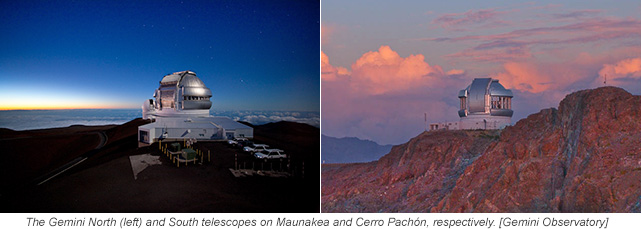Gemini's Green Energy Initiatives: A Key to Leaner Operations
Bryan Miller Gemini Observatory / NSF's NOIRLab
This article originally appeared on the AAS Sustainability Committee blog:
Over the last five years the Gemini Observatory has been adapting itself to a 25% reduced operations budget due to the withdrawal of the United Kingdom from the Gemini partnership in 2012. One goal of this effort is to save $1.5 million per year in non-labor operations costs. A substantial fraction of that savings comes a reduction in energy use due to improved efficiency and new green energy initiatives.
The first step was to make the current facilities more efficient to reduce electricity use. We have already improved energy management at the La Serena base facility and remodeled both summit and base data centers to reduce the energy — and money — needed to cool the computer systems. Changes in progress or that are being planned include replacing aging chillers on the summits with more efficient models, updating the transformers in Hawaii, and converting light fixtures to use LED bulbs. Combined, these efforts will save approximately $230,000 per year by 2017, assuming 2015 energy prices. Gemini will also continue to look for opportunities for additional savings.
In addition to efficiency savings, Gemini is investing in new green energy generation capabilities in order to reduce the amount of power that has to be purchased. Most of this is happening on Hawaii, where the electricity costs are much higher than the US average. The installation of 300 photovoltaic (PV) panels on the roof of the Gemini North support building on Maunakea has just been completed. This 100-kilowatt system will save $60,000 a year. Another 100-kW PV system is also being planned for the roof of the Hilo base facility. It is hoped that the installation contract will be approved by the end of 2015. Once fully installed this should save about $40,000 a year. Finally, a 200-kW PV system is being planned for Gemini South on Cerro Pachón, Chile. This should lead to an additional reduction in energy costs of around $40,000 per year. With these significant saving the investment in the panels should be returned within five years.
These efforts show how green energy makes financial sense as well as being good for the planet. Between energy efficiency improvements and green energy production, Gemini plans to save approximately $370,000 per year (assuming 2015 energy costs), or about 25% of the desired non-labor savings. In the process, Gemini's carbon footprint will be reduced by approximately 3,500 tons of CO2 per year.


